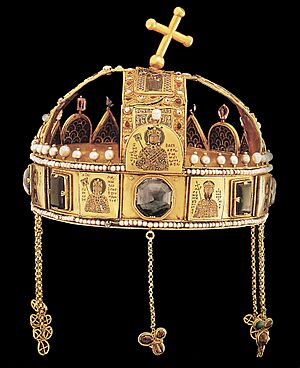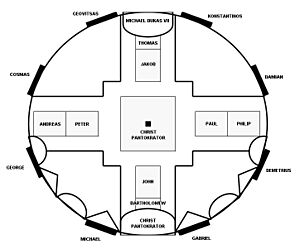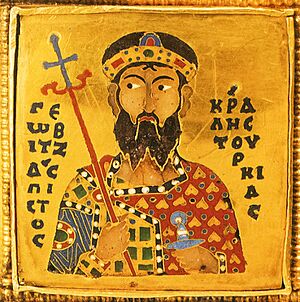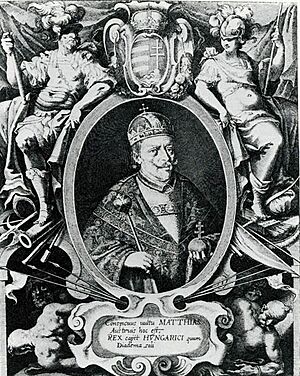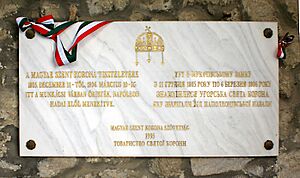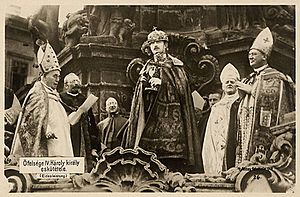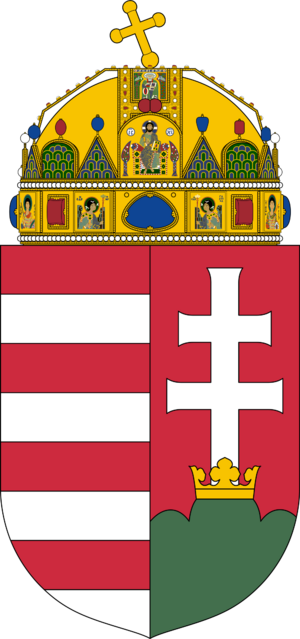Holy Crown of Hungary facts for kids
Quick facts for kids Holy Crown of Hungary |
|
|---|---|
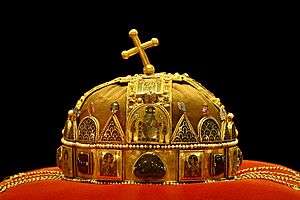
Front of the Holy Crown
|
|
| Heraldic depictions | |
 |
|
| Details | |
| Country | Hungary |
| Weight | 2,056 grams (72.5 oz) |
| Arches | 4 |
The Holy Crown of Hungary (Hungarian: Szent Korona), also known as the Crown of Saint Stephen, is a very important symbol for Hungary. It is named after Stephen I of Hungary, who was Hungary's first king. For hundreds of years, Hungarian kings were crowned with this special crown.
The crown showed the king's power over the lands of Hungary. It was a key sign that a king was the true ruler. More than fifty kings have been crowned with it. The last king to wear it was Charles I of Austria in 1916. Only a few kings were not crowned with it, like Joseph II, Holy Roman Emperor.
Many parts of the crown, especially the colorful enamel pictures, were made in the Byzantine Empire. This was likely in the 1070s. The Byzantine Emperor Michael VII Doukas probably gave the crown to King Géza I of Hungary. Both are shown on the crown's enamel pictures.
However, many people believed the Holy Crown was much older. They thought it came from the Pope and was given to King Stephen I around 1000 or 1001. The Holy Crown is one of only two known Byzantine crowns that still exist today.
The name "Holy Crown" was first used in 1256. By the 1300s, it became the main symbol of royal power. A Crown Guard named Péter Révay once said that the Holy Crown was as important to Hungarians as the Ark of the Covenant was to the Jewish people.
Since 2000, the Holy Crown has been on display in the main hall of the Hungarian Parliament Building.
Contents
How the Crown Looks
The Holy Crown is not perfectly round. It is shaped like an oval, about 20.4 cm wide and 21.6 cm long. This means it is larger than a normal human head. During coronations, the king had to wear a leather cap inside it.
The crown weighs about 2056 grams, which is about 4.5 pounds. The gold and silver parts of the crown have different metal mixes. The lower part of the crown is also not perfectly even.
Parts of the Crown
The Holy Crown is made of gold and decorated with nineteen enamel pictures. These pictures are called "pantokrator," which means "master of all" in Greek. It also has semi-precious stones, real pearls, and red almandine gems. The crown has three main parts:
- The lower part, called the corona graeca (Greek Crown).
- The upper part, called the corona latina (Latin Crown), which has cross straps.
- A cross on top that is tilted.
There are also four small decorations called pendilia that hang from chains on the sides and one at the back.
The Greek Part (Corona Graeca)
The lower part of the crown, the corona graeca, is 5.2 cm wide and has a diameter of 20.5 cm. The two blue stones at the back were added later by King Matthias II.
On the front of this part, there is a picture of Christ Pantokrator. To the left and right of Jesus, there are pictures of the archangels Michael and Gabriel. Next to them are pictures of Saint George, Saint Demetrius, and Saints Cosmas and Damian.
On the back, there is a picture of Michael VII Doukas, the Byzantine Emperor. Below him are pictures of "Kon. Porphyrogennetos" (likely his brother or son) and Hungarian King Géza I. The Greek writing next to Géza's picture calls him "faithful king of the land of the Turks." At that time, the Byzantines often called Hungarians "Turks."
The pictures of the emperors and saints have halos, but King Géza's picture does not. The names of the emperors are written in red, while the Hungarian king's name is in dark blue or black. This shows the difference in their importance.
Some experts believe the corona graeca was originally a woman's crown. It might have been given by Emperor Michael VII to King Géza's wife around 1075. It might have been an older crown that was changed for the Hungarian queen.
The Latin Part (Corona Latina)
The upper part, the corona latina, is made of four gold strips. These strips are attached to a square piece in the middle. They were probably made for another object and then added to the crown. This part is not meant to be separate. It was designed to sit on top of the corona graeca to create a dome shape.
The writing on the pictures of the saints and the style of the letters suggest when they were made. These letters are similar to those used on Byzantine coins before the mid-1000s. These pictures might have been on a special box for holy items or a portable altar given to King Stephen I by the Pope.
The intersecting bands have beaded gold wire. There are twelve pearls on the central part and seventy-two pearls in total on the corona latina. These pearls represent the number of Christ's disciples.
The central part has an enamel picture of Christ Pantokrator. Each band has two pictures of standing apostles, making eight in total.
The Cross on Top
The cross on top of the crown is attached in a simple way. It rises from the middle of the Christ picture on the crown's top. This cross might have been added in the 1500s. In the 1600s, the cross got bent. This might have happened when the crown was put away too quickly in its storage chest. The cross has been left in this slanted position ever since.
Some historians believe the current plain cross replaced an older, more special cross. This older cross might have held three pieces of the True Cross (the cross Jesus was crucified on). If this is true, it would explain why the crown was considered "holy."
Why is the Crown "Holy"?
Like many old European crowns, the Holy Crown symbolizes a halo. This halo showed that the king had a "divine right" to rule, meaning God had chosen him.
A popular story says that Saint Stephen I held up the crown before he died in 1038. He offered it and his kingdom to the Virgin Mary. After this, Mary was seen not only as the patron saint of Hungary but also as its queen. This act was believed to give the crown special power. This idea became known as the "Doctrine of the Holy Crown."
Under this doctrine, the crown itself is like a legal person, representing the state of Hungary. It is even more important than the king, who rules "in the name of the crown."
Where Did the Crown Come From?
Most experts believe the Holy Crown has three parts: the lower Greek part, the upper Latin cross straps, and the tilted cross. It was likely put together under Béla III, a Hungarian king who grew up in the Byzantine court. This happened many decades after Stephen I became king around 1000 or 1001.
Another story about the crown's origin was written by Bishop Hartvik around 1100. He wrote that the Pope sent King Stephen I "his blessings and a crown." According to this story, Saint Stephen sent Archbishop Astrik to Rome to get a crown from the Pope. The story says an angel told the Pope to give the crown to Astrik, even though another envoy arrived first.
This story became popular in Hungary around 1200 and named Pope Sylvester II as the Pope who sent the crown. However, historians have not found strong evidence to support this legend. For example, the "Greater Legend" of Saint Stephen, written around 1083, does not mention the crown coming from Rome. Also, the Vatican archives have no record of such a gift.
When the crown was returned to Hungary in 1978, it was carefully examined. Experts found that the different styles of the enamel pictures and the use of both Greek and Latin writing suggest the two main parts were made at different times. However, all old pictures of the crown show it as one piece.
The Crown Today
After the fall of the Communist government in Hungary, the Holy Crown was put back on the national coat of arms in 1990.
The Holy Crown has had an exciting history. It has been stolen, hidden, lost, found, and taken to other countries many times. In the past, it was kept in different cities like Székesfehérvár, Visegrád, or Bratislava. In 1805, it was kept for a few months in the Palanok Castle in Mukacheve.
After the Hungarian Revolution of 1848, Lajos Kossuth took the crown and other royal jewels and buried them in a forest. They were later dug up and returned to the royal castle in 1853.
At the end of World War II, the crown jewels were found in Austria by the U.S. Army. The Hungarian Crown Guard gave them to the U.S. Army for safekeeping, away from the Soviet Union. For much of the Cold War, the crown was kept at Fort Knox in Kentucky, USA.
After a lot of research to make sure the crown was real, U.S. President Jimmy Carter returned it to the people of Hungary on January 6, 1978.
Other Royal Items
Hungary is unique in Europe because most of its old royal coronation items have survived. On January 1, 2000, the Holy Crown was moved to the Hungarian Parliament Building. The sceptre, orb, and coronation sword were also moved there.
The very large coronation mantle is kept in a special glass case at the National Museum. It is very old and delicate. Unlike the crown, the mantle is believed to date back to King Stephen I, made around 1030. Old records say the queen and her sisters made it. The back of the mantle shows the only known picture of King Stephen, and it shows his crown was not the one we see today.
The sceptre is considered the most artistic piece of the Hungarian royal collection. It has a solid rock crystal ball decorated with carved lions. This ball is a rare item from the 900s. Its handle is made of wood with beautiful silver decorations.
The orb is special because it has a patriarchal cross (a cross with two horizontal bars) instead of a simple cross, just like the crown.
The ceremonial straight sword in the collection was made in Italy in the 1300s. However, another sword, said to be King Stephen I's original coronation sword, has been in Prague's St. Vitus Cathedral since 1368.
A lance that supposedly belonged to King Stephen I, and is seen in his portrait on the mantle, was reportedly taken by the Holy Roman Emperor around 1100.
See also
- Hungarian Crown
- Crown jewels
- Holy Crown Society


